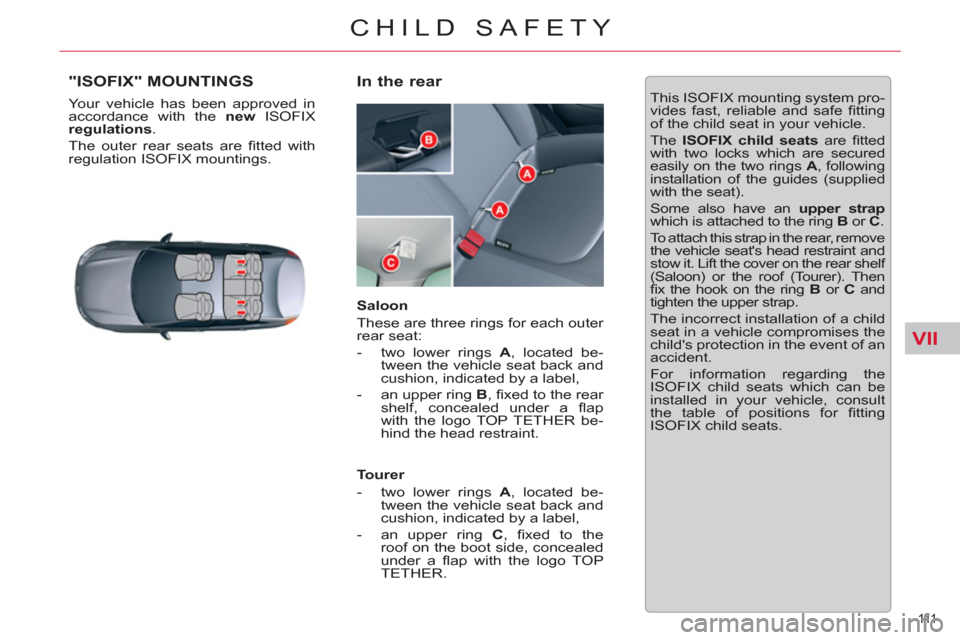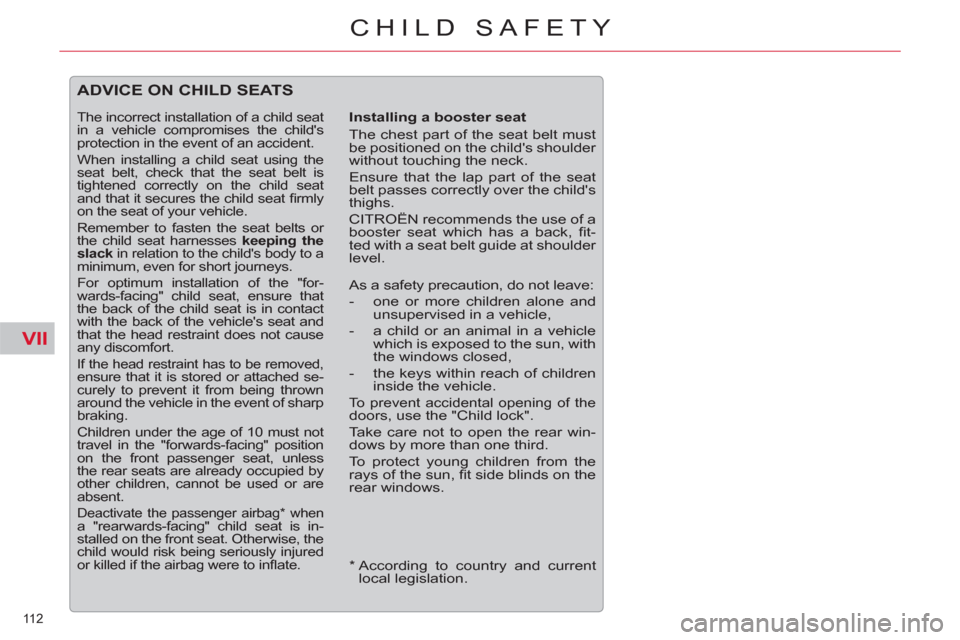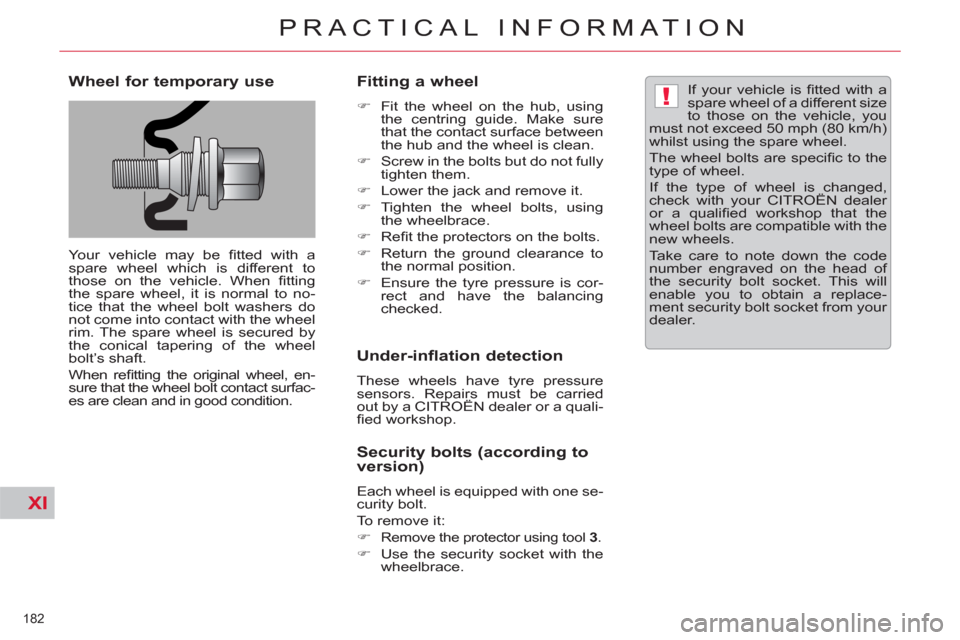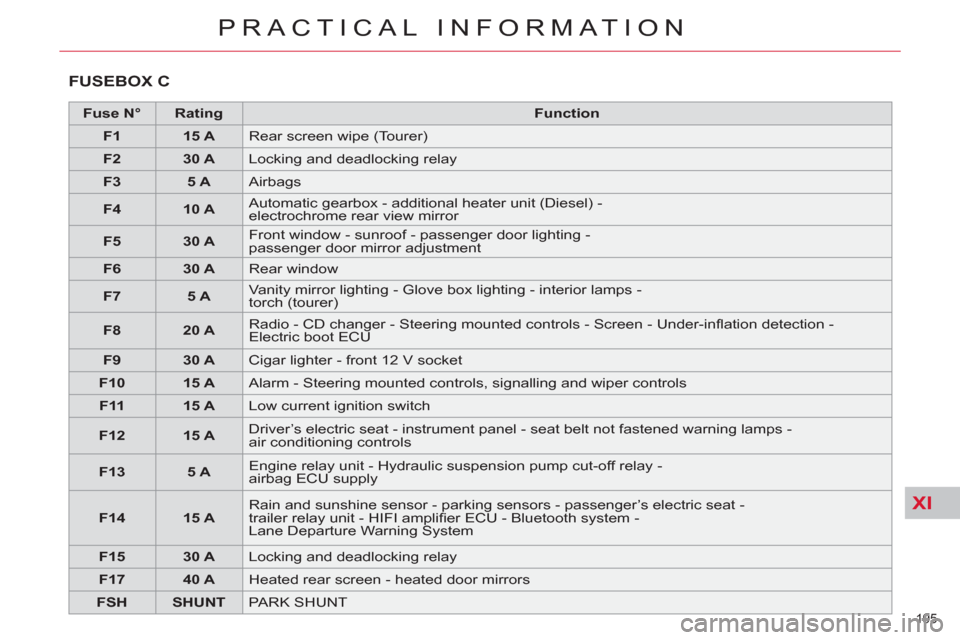ECU Citroen C5 RHD 2011.5 (RD/TD) / 2.G User Guide
[x] Cancel search | Manufacturer: CITROEN, Model Year: 2011.5, Model line: C5 RHD, Model: Citroen C5 RHD 2011.5 (RD/TD) / 2.GPages: 340, PDF Size: 39.33 MB
Page 113 of 340

VII
111
CHILD SAFETY
"ISOFIX" MOUNTINGS
Your vehicle has been approved in
accordance with the new ISOFIX
regulation
s
.
The outer rear seats are fi tted with
regulation ISOFIX mountings.
In the rear
This ISOFIX mounting system pro-
vides fast, reliable and safe fi tting
of the child seat in your vehicle.
The ISOFIX child seats
are fi tted
with two locks which are secured
easily on the two rings A
, following
installation of the guides (supplied
with the seat).
Some also have an upper strap
which is attached to the ring B
or C
.
To attach this strap in the rear, remove
the vehicle seat's head restraint and
stow it. Lift the cover on the rear shelf
(Saloon) or the roof (Tourer). Then
fi x the hook on the ring B
or C
and
tighten the upper strap.
The incorrect installation of a child
seat in a vehicle compromises the
child's protection in the event of an
accident.
For information regarding the
ISOFIX child seats which can be
installed in your vehicle, consult
the table of positions for fi tting
ISOFIX child seats.
Saloon
These are three rings for each outer
rear seat:
- two lower rings A
, located be-
tween the vehicle seat back and
cushion, indicated by a label,
- an upper ring B
, fi xed to the rear
shelf, concealed under a fl ap
with the logo TOP TETHER be-
hind the head restraint.
Tourer
- two lower rings A
, located be-
tween the vehicle seat back and
cushion, indicated by a label,
- an upper ring C
, fi xed to the
roof on the boot side, concealed
under a fl ap with the logo TOP
TETHER.
Page 114 of 340

VII
112
CHILD SAFETY
*
According to country and current
local legislation.
ADVICE ON CHILD SEATS
Installing a booster seat
The chest part of the seat belt must
be positioned on the child's shoulder
without touching the neck.
Ensure that the lap part of the seat
belt passes correctly over the child's
thighs.
CITROËN recommends the use of a
booster seat which has a back, fi t-
ted with a seat belt guide at shoulder
level.
As a safety precaution, do not leave:
- one or more children alone and
unsupervised in a vehicle,
- a child or an animal in a vehicle
which is exposed to the sun, with
the windows closed,
- the keys within reach of children
inside the vehicle.
To prevent accidental opening of the doors, use the "Child lock".
Take care not to open the rear win-
dows by more than one third.
To protect young children from the
rays of the sun, fi t side blinds on the
rear windows.
The incorrect installation of a child seat
in a vehicle compromises the child's
protection in the event of an accident.
When installing a child seat using the
seat belt, check that the seat belt is
tightened correctly on the child seat
and that it secures the child seat fi rmly
on the seat of your vehicle.
Remember to fasten the seat belts or
the child seat harnesses keeping the
slack
in relation to the child's body to a
minimum, even for short journeys.
For optimum installation of the "for-
wards-facing" child seat, ensure that
the back of the child seat is in contact
with the back of the vehicle's seat and
that the head restraint does not cause
any discomfort.
If the head restraint has to be removed, ensure that it is stored or attached se-
curely to prevent it from being thrown
around the vehicle in the event of sharp
braking.
Children under the age of 10 must not
travel in the "forwards-facing" position
on the front passenger seat, unless
the rear seats are already occupied by
other children, cannot be used or are
absent.
Deactivate the passenger airbag * when a "rearwards-facing" child seat is in-
stalled on the front seat. Otherwise, the
child would risk being seriously injured
or killed if the airbag were to infl ate.
Page 115 of 340

VII
11 3
CHILD SAFETY
ISOFIX CHILD SEAT RECOMMENDED BY CITROËN AND APPROVED FOR YOUR VEHICLE
This child seat can also be used on seats which are not fi tted with ISOFIX mountings. In this case, it must be attached
to the vehicle seat using the three point seat belt.
Follow the instructions for fi tting the child seat given in the seat manufacturer’s installation guide.
RÖMER Duo Plus ISOFIX
(size category B1
)
Group 1: from 9 to 18 kg
Installed in the forwards-facing position.
Fitted with an upper strap to be secured on the upper ring B
or C
, referred to
as the TOP TETHER.
Three seat body angles: sitting, reclining, lying.
Page 123 of 340

VIII
121
SAFETY
SEAT BELTS
Front seat belts
The front seat belts are fi tted with a
pretensioning system and force limiter.
This system improves safety in the front seats in the event of a front impact.
Depending on the seriousness of the
impact, the pretensioning system in-
stantly tightens the seat belt against
the body of the occupant.
Fastening
�)
Pull the belt down in front of you
in a steady movement, making
sure that it does not become
twisted.
�)
Press the fastening into its buckle.
�)
Check that it is properly secured
and that the automatic locking
mechanism operates correctly
by pulling sharply on the belt
strap.
�)
The lap strap should be posi-
tioned as low down as possible in
the lap and as tight as possible.
�)
The diagonal strap should be
positioned across the chest and
away from the neck.
Each belt has a reel that adjusts its
length automatically to the girth of
the seat occupant.
The pretensioning seat belts are
active when the ignition is on.
The force limiter reduces the pres-
sure of the seat belt against the
chest of the occupant, so increasing
his protection.
Reactivation
Below 30 mph (50 km/h), press the
"ESP OFF"
button to reactivate
these systems.
They are reactivated automatically
above 30 mph (50 km/h) or every
time the ignition is switched off.
Operating fault
If this warning lamp comes
on, accompanied by an
audible signal and a mes-
sage in the instrument panel
screen, this indicates a fault with
these systems.
Have it checked by a CITROËN
dealer or a qualifi ed workshop.
The ESP/ASR systems offer ex-
ceptional safety in normal driving,
but this should not encourage the
driver to take extra risks or drive at
high speed.
The correct operation of these sys-
tems depends on observation of
the manufacturer's recommenda-
tions regarding the wheels (tyres
and rims), the braking components,
the electronic components and ob-
servation of the assembly and re-
pair procedures used by CITROËN
dealers.
After an impact, have these systems
checked by a CITROËN dealer or a
qualifi ed workshop.
Page 125 of 340

VIII
123
SAFETY
The driver must ensure that passen-
gers use the seat belts correctly and
that they are all restrained securely
before setting off.
Wherever you are seated in the ve-
hicle, always fasten your seat belt,
even for short journeys.
Do not interchange the seat belt
buckles as they will not fulfi l their
role fully.
The seat belts are fi tted with an
inertia reel permitting automatic
adjustment of the length of the strap
to your size. The seat belt is stowed
automatically when not in use.
Before and after use, ensure that the
seat belt is reeled in correctly.
The lower part of the strap must be
positioned as low as possible on the
pelvis.
The upper part must be positioned
in the hollow of the shoulder.
The inertia reels are fi tted with an
automatic locking device which
comes into operation in the event
of a collision, emergency braking or
if the vehicle rolls over. You can re-
lease the device by pulling fi rmly on
the strap and releasing it so that it
reels in slightly. In order to be effective, a seat belt
must:
- be tightened as close to the body
as possible,
- be pulled in front of you with a
smooth movement, checking
that it does not twist,
-
be used to restrain only one person,
- not bear any trace of cuts or
fraying,
- not be converted or modifi ed to
avoid affecting its performance.
Recommendations for children
Use a suitable child seat if the pas-
senger is less than 12 years old or
shorter than one and a half metres.
Never use the same seat belt to se-
cure more than one person.
Never allow a child to travel on
your lap.
In accordance with current safety
regulations, for all repairs on your
vehicle, go to a qualifi ed workshop
with the skills and equipment need-
ed, which a CITROËN dealer is able
to provide.
Have your seat belts checked reg-
ularly by a CITROËN dealer or a
qualifi ed workshop, particularly if the
straps show signs of damage.
Clean the seat belt straps with soapy
water or a textile cleaning product,
sold by CITROËN dealers.
After folding or moving a seat or rear
bench seat, ensure that the seat belt
is positioned and reeled in correctly.
In the event of an impact
Depending on the nature and se-
riousness of the impact
, the pre-
tensioning device may be deployed
before and independently of the
airbags. Deployment of the preten-
sioners is accompanied by a slight
discharge of harmless smoke and
a noise, due to the activation of the
pyrotechnic cartridge incorporated
in the system.
In all cases, the airbag warning lamp
comes on.
Following an impact, have the seat
belts system checked, and if neces-
sary replaced, by a CITROËN dealer
or a qualifi ed workshop.
Page 129 of 340

VIII
127
SAFETY
For the airbags to be fully
effective, observe the following
safety rules:
Sit in a normal upright position.
Wear a correctly adjusted seat belt.
Do not leave anything between the
occupants and the airbags (a child,
pet, object...). This could hamper the
operation of the airbags or injure the
occupants.
After an accident or if the vehicle
has been stolen or broken into, have
the airbag systems checked.
All work on the airbag system must
be carried out by a CITROËN dealer
or a qualifi ed workshop.
Even if all of the precautions men-
tioned are observed, a risk of injury
or of minor burns to the head, chest
or arms when an airbag is deployed
cannot be ruled out. The bag in-
fl ates almost instantly (within a few
milliseconds) then defl ates within the
same time discharging the hot gas
via openings provided for this pur-
pose.
Front airbags
Do not drive holding the steering
wheel by its spokes or resting your
hands on the centre part of the
wheel.
Passengers must not place their feet
on the dashboard.
If possible, do not smoke as deploy-
ment of the airbags can cause burns
or the risk of injury from a cigarette
or pipe.
Never remove or pierce the steering
wheel or hit it violently.
Lateral airbags
Use only approved covers on the
seats, compatible with the deployment
the lateral airbags. For information
on the range of seat covers suitable
for your vehicle, you can contact a
CITROËN dealer (see "Practical infor-
mation - § Accessories").
Do not fi x or attach anything to the
seat backs (clothing...). This could
cause injury to the chest or arms if
the lateral airbag is deployed.
Do not sit with the upper part of the
body any nearer to the door than
necessary.
Curtain airbags
Do not fi x or attach anything to the
roof. This could cause injury to the
head if the curtain airbag is de-
ployed.
If fi tted on your vehicle, do not re-
move the grab handles installed on
the roof, they play a part in securing
the curtain airbags.
Page 134 of 340

IX
!
!
132
DRIVING
Dynamic emergency braking
In the event of a failure of the ve-
hicle’s main braking system or in
an exceptional situation (e.g. driver
taken ill, under instruction, etc) pull
and hold control lever A
to stop the
vehicle.
The electronic stability programme
(ESP) provides stability during dy-
namic emergency braking.
If there is a fault with the dynamic
emergency braking, one of the fol-
lowing messages will be displayed
in the instrument panel screen:
- "Parking brake faulty".
- "Parking brake control faulty". If a failure of the ESP system
is signalled by the lighting
of this warning lamp, then
braking stability is not guar-
anteed. In this event, stability must
be assured by the driver by repeat-
ing alternate "pull release" actions on
control lever A
.
The dynamic emergency
braking should only be used
in exceptional circumstances.
Emergency parking brake
release
In the event of the electric parking
brake failing to release, an emergency
device can be used to release the
parking brake manually, provided that
it is possible to immobilise the vehicle
while the procedure is carried out.
�)
If you can start the vehicle: with
the engine running, immobilise
the vehicle by applying the foot
brake while the operation is being
carried out.
�)
If you are unable to start the
vehicle (fl at battery for example):
do not use this device and contact
a CITROËN dealer or a qualifi ed
workshop. However, if you are
obliged to proceed, fi rst immobilise
your vehicle securely and then fol-
low the instructions below. If the vehicle cannot be im-
mobilised, do not operate
the emergency release. Your ve-
hicle may run away if on a slope.
Contact a CITROËN dealer or a
qualifi ed workshop.
Page 182 of 340

XI
!
180
PRACTICAL INFORMATION
Access to the spare wheel
To remove the spare wheel
�)
Lift up the boot fl oor and fold in
two (Saloon) or hook it using the
retractable handle (Tourer).
�)
Detach the strap then push the
wheel forwards so as to be able
to lift it.
To reposition the spare wheel
�)
Position the spare wheel fl at in
the boot, then pull it towards
you.
�)
Next place the toolbox inside the
wheel, then secure the assembly
with the strap.
�)
Release the boot fl oor to return it
to its initial position.
The tyre pressures are indi-
cated on the label located on
the driver's side centre door
pillar. Tyre pressures are given for
different vehicle loading conditions.
Page 184 of 340

XI
!
182
PRACTICAL INFORMATION
Wheel for temporary use
Your vehicle may be fi tted with a
spare wheel which is different to
those on the vehicle. When fi tting
the spare wheel, it is normal to no-
tice that the wheel bolt washers do
not come into contact with the wheel
rim. The spare wheel is secured by
the conical tapering of the wheel
bolt’s shaft.
When refi tting the original wheel, en-
sure that the wheel bolt contact surfac-
es are clean and in good condition.
Fitting a wheel
�)
Fit the wheel on the hub, using
the centring guide. Make sure
that the contact surface between
the hub and the wheel is clean.
�)
Screw in the bolts but do not fully
tighten them.
�)
Lower the jack and remove it.
�)
Tighten the wheel bolts, using
the wheelbrace.
�)
Refi t the protectors on the bolts.
�)
Return the ground clearance to
the normal position.
�)
Ensure the tyre pressure is cor-
rect and have the balancing
checked.
Under-inflation detection
These wheels have tyre pressure
sensors. Repairs must be carried
out by a CITROËN dealer or a quali-
fi ed workshop.
Security bolts (according to
version)
Each wheel is equipped with one se-
curity bolt.
To remove it:
�)
Remove the protector using tool 3
.
�)
Use the security socket with the
wheelbrace.
If your vehicle is fi tted with a
spare wheel of a different size
to those on the vehicle, you
must not exceed 50 mph (80 km/h)
whilst using the spare wheel.
The wheel bolts are specifi c to the
type of wheel.
If the type of wheel is changed,
check with your CITROËN dealer
or a qualifi ed workshop that the
wheel bolts are compatible with the
new wheels.
Take care to note down the code
number engraved on the head of
the security bolt socket. This will
enable you to obtain a replace-
ment security bolt socket from your
dealer.
Page 197 of 340

XI
195
PRACTICAL INFORMATION
FUSEBOX C
Fuse N°
Rating
Function
F1
15 A
Rear screen wipe (Tourer)
F2
30 A
Locking and deadlocking relay
F3
5 A
Airbags
F4
10 A
Automatic gearbox - additional heater unit (Diesel) -
electrochrome rear view mirror
F5
30 A
Front window - sunroof - passenger door lighting -
passenger door mirror adjustment
F6
30 A
Rear window
F7
5 A
Vanity mirror lighting - Glove box lighting - interior lamps -
torch (tourer)
F8
20 A
Radio - CD changer - Steering mounted controls - Screen - Under-infl ation detection -
Electric boot ECU
F9
30 A
Cigar lighter - front 12 V socket
F10
15 A
Alarm - Steering mounted controls, signalling and wiper controls
F11
15 A
Low current ignition switch
F12
15 A
Driver’s electric seat - instrument panel - seat belt not fastened warning lamps -
air conditioning controls
F13
5 A
Engine relay unit - Hydraulic suspension pump cut-off relay -
airbag ECU supply
F14
15 A
Rain and sunshine sensor - parking sensors - passenger’s electric seat -
trailer relay unit - HIFI amplifi er ECU - Bluetooth system -
Lane Departure Warning System
F15
30 A
Locking and deadlocking relay
F17
40 A
Heated rear screen - heated door mirrors
FSH
SHUNT
PARK SHUNT